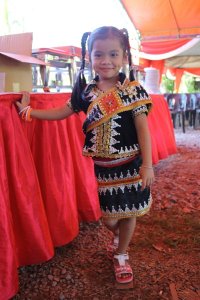“Sinuangga” and “tapi” is known as the traditional garments for Kadazandusun women. They wear short shirts which is sinuangga, wrap-skirt tapi and batik scarf fitted with belt himpogot (silver dollar coins) and some gold jewellery such as necklace (hamai), bangles (gohong), earrings (simbong), ring (sinsing) and brooch (pawn). The basic material for making sinuangga is black commercial fabric, silk or velvet for ceremonial occasions. It is made from cotton for daily wear. Sinuangga is a blouse with short sleeves and U-neck worn by younger women. It is having sober embroidery along the opening for head and arms, and along the seams at the sides and along the middle of the back which is red, yellow and cream cotton yarn.
The gold-plated silver betawi buttons are looped through a string on the inside. Betawi buttons used to be fixed all the way up to the neck for ceremonial occasions and half way up from the lower end of the blouse for daily wear. Now days, the buttons are tied together from the top down to the bottom of the blouse with a cotton thread. There are thirty or more gold buttons sewn in a double row on sinuangga.
“Tapi” is a long cylindrical wrap-skirt and formerly of plain black cotton. Now days, it is often enlivened with siring which is gold trimming, running over the hips, in front of the skirt, crossed by another band of trimming from the waist down. A Kadazandusun lady wearing the traditional costume normally emphasize the slimness of their waist is considered as beautiful.
Every culture most definitely has it’s own unique way of dressing up. For the Kadazan-Dusun’s they have a traditional outfit that is worn on special occasions. As the pictures above show, the traditional costume for both the men and women have a velvet black base and gold trimmings. According to tradition, for the women, the length of their sleeves carry different meanings which I will explain in detail.
Many have wondered why the Kadazan-Dusun’s have chosen black as the color for their traditional costumes as it is a very sombre color, after an interview I had with a friends mother, she explained that the color was not chosen specifically, it was out of necessity as in the past, the fruits and vegetables their ancestors used to extract dye, in which they only extracted dark hues and therefore settled with the color black. To add color the Kadazan-Dusun people donned accessories that were gold and silver in color, which are most of the time heirlooms passed down from generation to generation.
The traditional costumes of the women is the black blouse with gold trimmings called siya or sinuangga. There are normally eight gold buttons (kubamban) down the front of the blouses and an equal number of the similar buttons are stitched on the sleeves. The lenght of the sleeves worn by women represent their age, short sleeved blouses are worn by the younger generation, ¾ sleeves are traditionally worn by middle-aged ladies and lastly, and the long sleeves(kihongon) are worn by the older generation and as well as female ritual specialists. A plain white blouse (simis) is normally worn under the siya. A black velvet knee-length or long skirt or sarong (gonob) is paired with the blouse. The traditional costume worn by the females normally is worn with a belt consisting of silver doller coins, these belts (ruppiah). Three belts are worn for the unmarried, two for the married and one belt for a widow or any older woman. Other accessories that are used together with the traditional costume are:
Titimbak Hairpin to decorate and fasten the hairbun.
Tiningkokos Brass or silver spiral bracelet.
Gohong Brass or silver bracelets.
Hamai Necklace.
Simbong Earrings.
Paun Brooch of gold coin(s).
As for the men, their traditional costume is almost similar to the ladies. The black long-sleeved shirt (Gaung) decorated with gold trimming and gold buttons. The black trousers worn with the shirt is called souva, which also has gold details and trimmings. The men also traditionally don black waist sash (Kaking or toogot). The unique aspect of the mens costume is that they are to wear headgears out of woven dastar cloth, that is folded and twisted in many ways that leave only a small corner of the cloth sticking out.
These costumes have retained much of their original design and color and has not been influenced by many changes over the years.
References: http://intercultural-comm1.blogspot.com/


